Artillery in Ireland: Dublin, National Museum of Ireland, Arbour Hill, Beggars Bush, Clancy Barracks, Collins Barracks, and McKee Barracks
Artillery preserved in Ireland, Dublin,
National Museum of Ireland, Arbour Hill, Beggars Bush, Clancy Barracks, Collins Barracks, and McKee Barracks
The aim of this website is to locate, identify and document every historical piece of artillery preserved in Ireland. Many contributors have assisted in the hunt for these guns to provide and update the data found on these web pages. Photos are by the author unless otherwise credited. Any errors found here are by the author, and any additions, corrections or amendments to this list of Guns and Artillery in Ireland would be most welcome and may be e-mailed to the author at [email protected].
Dublin, National Museum of Ireland

(MGen (Ret'd) P.F. Nolan Photo)
Bronze 12-pounder Smoothbore Muzzleloading Gun, Royal Irish Artillery Regiment, 1796. National Museum of Ireland. This gun was one of a consignment of thirty-six guns, 6-pounders and 12-pounders, received by the Royal Irish Artillery Regiment in 1796. This regiment, established in 1756, had its headquarters in Chapelizod, Dublin from 1760 until its amalgamation with the Royal Artillery regiment, Woolwich, London, on passing of the Act of Union in 1801. The inscription on this 12-pounder gun include, the maker’s name, Francis Kinman, London, date of manufacture, 1794, the Irish harp with the Royal Irish Artillery motto, and the motto of the Marquess of Drogheda, the Master General of Ordnance in Ireland at that time. (Internet: http://www.militaryheritage.ie/military-heritage-projects/series-of-articles-national-museum/12-pounder-gun/)

(The Artillery Club, Ireland Photo)
Bronze 12-pounder Smoothbore Muzzleloading Gun, Royal Irish Artillery Regiment, 1796. National Museum of Ireland.

(Alan Wright Photo)
Spanish Armada Cannon.
The Spanish Armada was a fleet of 130 ships that sailed from A Coruña in August 1588 under the command of the Duke of Medina Sidonia with the purpose of escorting an army from Flanders to invade England. It met with armed resistance in the English Channel, when a fireship attack off Calais broke its formation, and was driven into the North Sea after the Battle of Gravelines.
When the fleet entered the North Sea, 110 ships remained under Medina Sidonia's command. Many were damaged by gunfire or were running low on supplies, making them unfit for service in the Atlantic Ocean. Some had cut their anchors in the flight from the fireships, which severely diminished their ability to navigate close to shore. Also, the Armada commanders made a large navigational error that brought the fleet too close to the dangerous Atlantic coasts of Scotland and Ireland.
The Spanish Armada in Ireland refers to the landfall made upon the coast of Ireland in September 1588 of a large portion of the 130-strong fleet sent by Philip II to invade England.Following its defeat at the naval battle of Gravelines, the Armada had attempted to return home through the North Atlantic, when it was driven from its course by violent storms, toward the west coast of Ireland. The prospect of a Spanish landing alarmed the Dublin government of Queen Elizabeth I, which prescribed harsh measures for the Spanish invaders and any Irish who might assist them.
Up to 24 ships of the Armada were wrecked on a rocky coastline spanning 500 km, from Antrim in the north to Kerry in the south, and the threat to Crown authority was readily defeated. Many of the survivors of the multiple wrecks were put to death, and the remainder fled across the sea to Scotland. It is estimated that some 6,000 members of the fleet perished in Ireland or off its coasts. (Wikipedia)
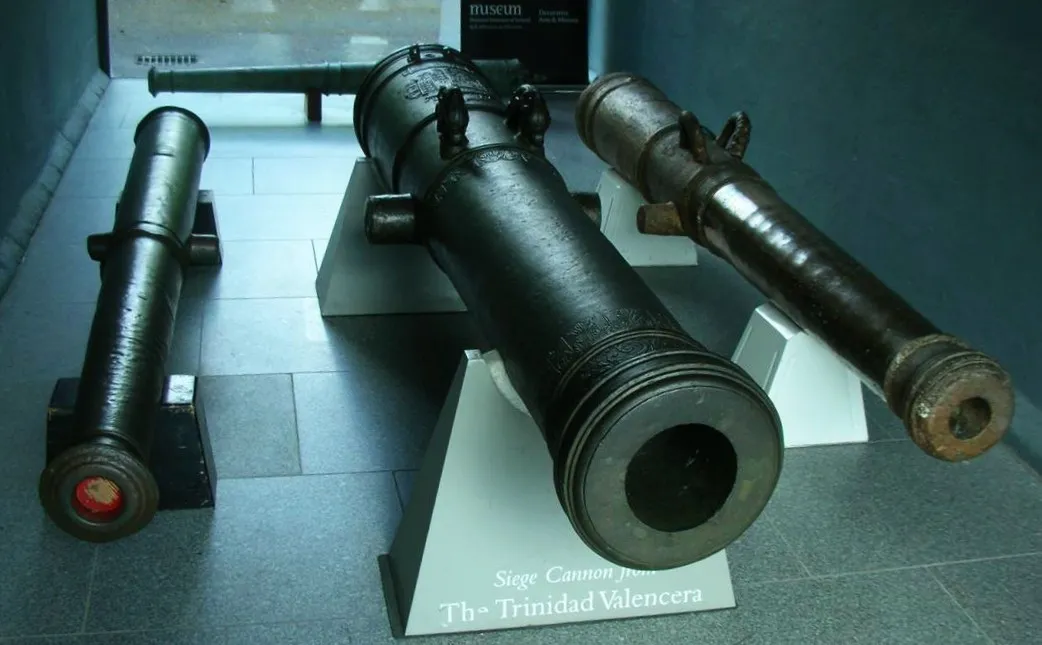
(Edward Bourke Photo)
Armada Cannons. The larger of these cannons, the siege cannon, was recovered from the Spanish Armada wreck of the Trinidad Valencera, off the coast of County Donegal. The Trinidad Valencera was a Venetian merchant ship that had been seized in Sicily in 1586 and forced into the service of Philip II of Spain. At 1,100 tonnes she was the fourth largest of the ships of the great armada of 1588, with which Philip tried to invade England. After a battle with the English and a violent storm, many ships from the fleet were wrecked around the Irish coastline.
The siege cannon was cast in 1556 by the Founder Royal, Remigy de Halut, in Brussels. It bears an inscription stating who made it, together with the arms of Philip II and is decorated with dolphins and stylised foliage. It is bronze, weighs 2.5 tonnes and would have fired a 41 lb iron ball. This was one of a number of siege guns that the 130-ship armada carried in preparation for the proposed conquest of England, together with 19,000 soldiers and their supplies.
The smaller ‘pedrero’ cannon from the Juliana was recovered off Streedagh Strand in County Sligo. The Juliana was one of three Armada vessels wrecked on this part of the coast in the storm of 21 September 1588, where they broke up and where the bodies of 1,000 crew members were later found. The pedrero cannon was small and comparatively light in weight. It fired a large stone ball and would have been a ferocious weapon at close quarters in ship to ship fighting.
When the cannons were raised, they were completely impregnated with salt from the sea. Salt, when combined with oxygen and water in the air, causes rapid corrosion in metal, so the salt had to be removed before the cannon could be dried out. This was achieved by placing the cannons in tanks of fresh water, alternating between hot and cold to make the metal expand and contract to force the salt out. The last two washes were carried out with de-ionised water, to ensure that the salt content of the cannons was as low as possible.
The cannons were then dried out thoroughly and the painstaking work of cleaning off corrosion and concretions could begin; a process which took several weeks. The layers of dirt and corrosion had to be carefully removed mechanically with hand tools to reveal the original surfaces of the cannons under them. A thin coating of lacquer was then applied, followed by a coating of wax to protect the cannons while on exhibition at Collins Barracks. (Internet:http://www.museum.ie/en/list/projects)
Iron Swivel cannon with a long tapering barrel, moulding round muzzle, and two short trunnions, Y-shaped supports for the trunnions. The gun has an open breech closed by a hinged breech block with hook attachment at its side. The gun also has a straight handle to the rear terminating in a knob. Probably English, 17th century.
Arms and armour in the museum collection include swords, pistols and long-arms, mainly Irish and English weapons from the 16th to the 20th Centuries, along with some from Europe and the USA. There is also a sizeable number non-Western muskets and swords collected in the 19th Century. The long-arms include flintlock, percussion and semi-automatic weapons. There are also a number of cannons. The edged weapons consist of swords, daggers, bayonets, pole-arms, some crossbows and clubs. (Internet: http://www.museum.ie/en/collection/arms-and-armour.aspx)
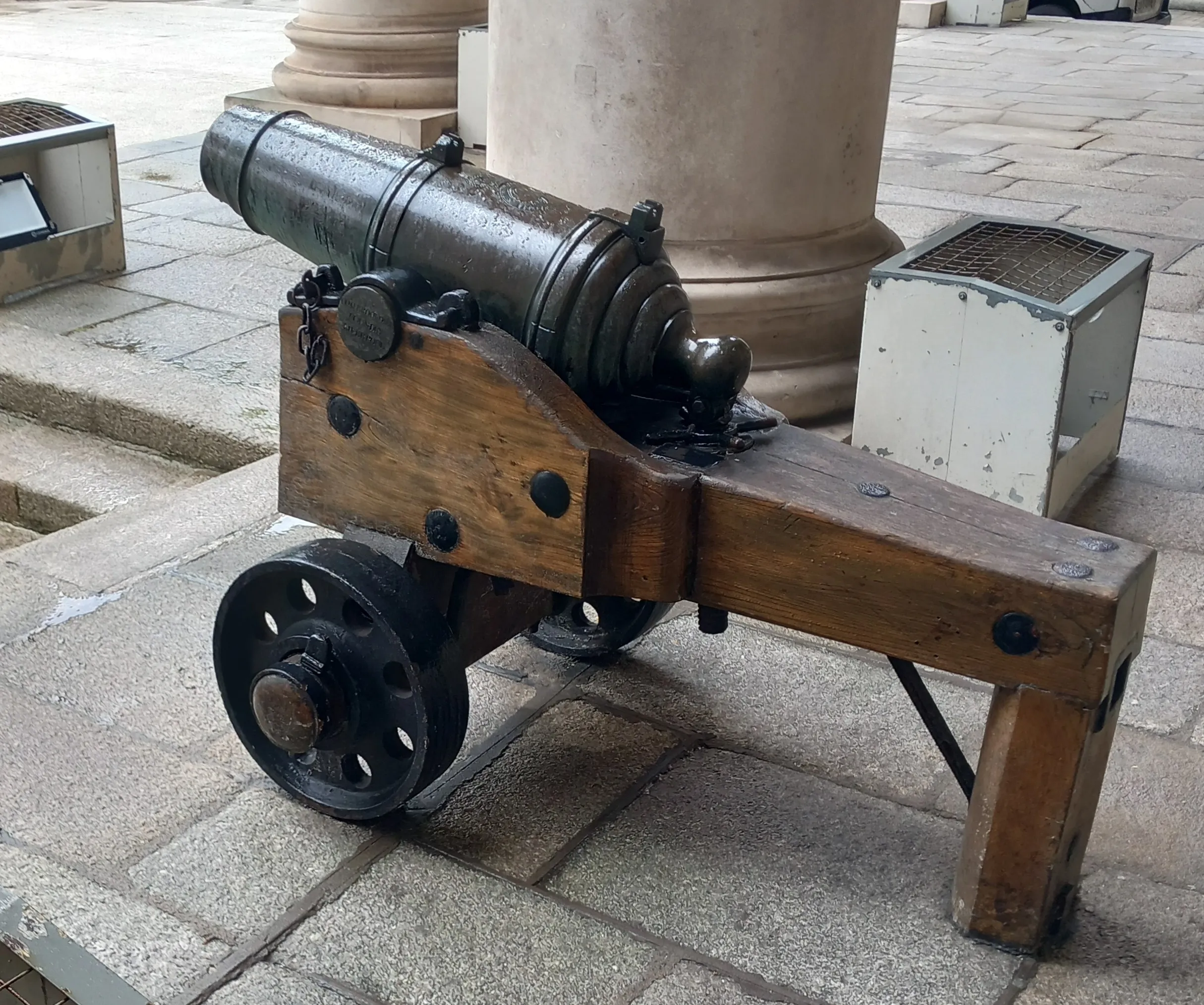

(Edward Bourke Photos)
Two Bronze 32-pounder Smoothbore Muzzleloading Carronades, King George I cypher, mounted on iron garrison carriages stand in front of the Bank of Ireland in Dublin.
COALBROOKDALE FOUNDRY LIVERPOOL on the left trunnion.
Two large 24-pounder Smoothbore Muzzleloading Guns with cannonballs cemented in their mouths, mounted on wood naval gun carriages in front of the Pigeon House gates, Dublin.
Six QF 12-pounder 12-cwt Mk. I Guns on Mk. I Garrison Carriages, are located in Dun Laoighaire Harbour, under the control of the 2nd Field Artillery Regiment.
Dublin, Dún Laoghaire, Forty Foot, Sandycove


(Aidan Keenan Photos)
.avif)
.avif)


.avif)
(Ian Cundy Photos)
Russian Cast Iron 24-pounder Smoothbore Muzzleloading Gun, P, No. 84 on the cascabel, with the double eagle and crown cypher of the Romanov family crest on the barrel. The gun is mounted on a wood naval gun carriage, standing on the harbour wall, East Pier, Dún Laoghaire. This cannon is a trophy from the Crimean War (1853-1856).
According to the Kingstown Town Commissioners minutes of 17 July 1857, 16 pounds was raised from the townships rates for the purchase of one "Russian gun" from the Secretary for War, Lord Panmure. The 24 pound gun arrived and was placed on a carriage that had been made at the Royal Arsenal in Woolwich, London. This Russian gun was one of nearly 3,000 that were captured during the Crimean War (1853-1856). Most of them were reportedly from the siege of Sebastopol - due to public discontent with the management of the war it is suspected that these numbers were exaggerated in order to show why the siege took so long. In the Treaty of Paris, which ended the war, it was agreed that each of the victors would receive cannons from the Russians as trophies of their victory. Some of these Russian guns were put on display in towns throughout Britain and Ireland. In Ireland over 20 towns are believed to have applied for and received a Russian gun for display. The Russian double eagle and crown of the Romanov family crest is still visible on the gun.

(The Artillery Club, Ireland Photo)
Ordnance QF 18-pounder Mk. IV field gun mounted on a wheeled Mk. IV carriage.
Dublin, Arbour Hill


(Colin Stone Photos)
Ordnance QF 25-pounder field gun, mounted on its firing platform.
Dublin, Beggars Bush
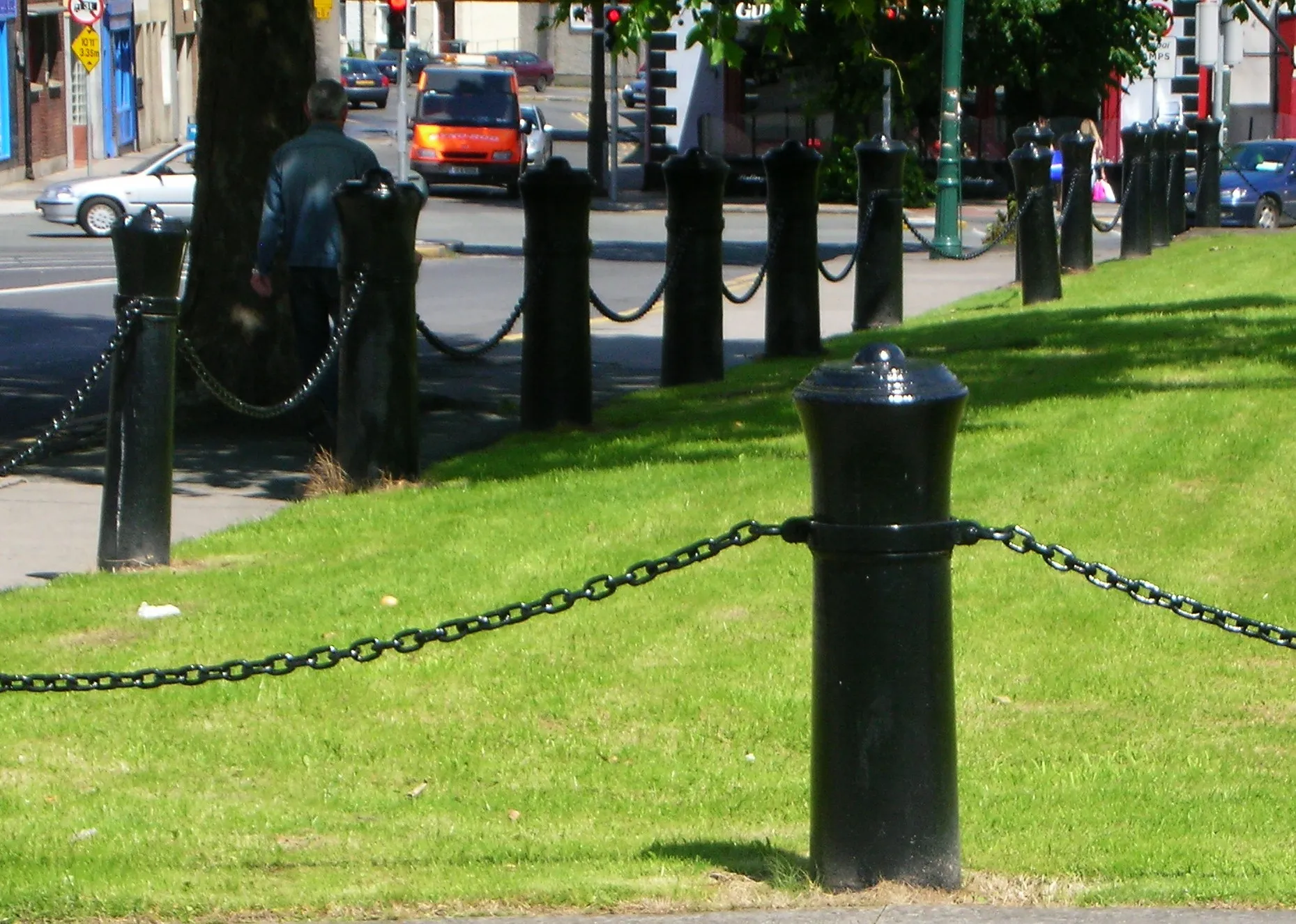
(Edward Bourke Photo)
Cast iron SBML guns serving as bollards. Beggars Bush (Irish: Tor an Bhacaigh) is the site of the former Beggars Bush Barracks on Haddington Road in the inner southern suburbs of Dublin, Ireland, as well the surrounding area and a nearby pub. The barracks were bordered to the east by Shelbourne Road, which used to be the western bank of the River Dodder.
Dublin, Clancy Barracks

(Colin Stone Photo)
Ordnance Quick-Firing 6-pounder 7 cwt anti-tank gun.
Dublin, Collins Barracks

(Colin Stone Photo)
Ordnance QF 18-pounder Mk. IV field gun mounted on a Mk. IV wheeled carriage.



(Colin Stone Photos)
Bofors 40-mm L/60 QF Light Anti-Aircraft Gun, mounted on a wheeled gun carriage..


(Colin Stone Photos)
QF 12-pounder 12-cwt Mk. I Gun mounted on a Mk. I Garrison Carriage.

(Colin Stone Photo)
Ordnance QF 18-pounder Mk. IV field gun mounted on a Mk. IV (P) wheeled carriage.
Dublin, McKee Barracks
The Irish Defence Forces maintain a 6 gun ceremonial 25 pounder Battery in McKee Barracks, a military installation near Phoenix Park in Cabra, Dublin. These guns were re-conditioned in 2003, with original parts, painted olive green with a chrome finish to the muzzle break.

(Colin Stone Photos)
Ordnance QF 4.5-inch howitzer. This was the standard British Empire field (or ‘light’) howitzer of the First World War era. It entered service in the UK in 1910 and remained in service through the interwar period and was last used in the field by British forces in early 1942. It was generally horse drawn until mechanisation in the 1930s.



(Colin Stone Photos)
Ordnance QF 18-pounder Mk. IV field gun mounted on a Mk. V(P) carriage, No. 1 of 2.
Mark V(P), where P = pneumatic tires.

(Colin Stone Photo)
Ordnance QF 18-pounder Mk. IV field gun mounted on a Mk. V(P) carriage, No. 2 of 2.
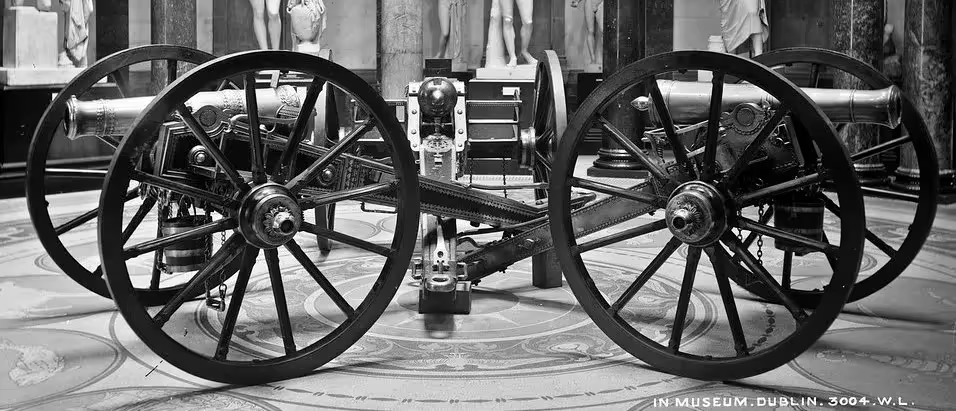
(Robert French Photo, courtesy of the National Library of Ireland, L Roy, 03004)
Four Sikh guns that were captured at the Battles of Sobraon or Mahrajpore during the Anglo-Sikh Wars were on display at the NMI Kildare St museum. One now stands within the NMI Collins Barracks collection, and two others are located at McKee barracks near Phoenix Park. A museum plaque stated the guns were, "Taken at the Battles of Mahrajpore and Sobraon during the Sikh Wars, and presented to Field Marshal, the late Lord Viscount Gough, K.P., G.C.B., G.C.I.J., by the honorable East India Company in 1846."
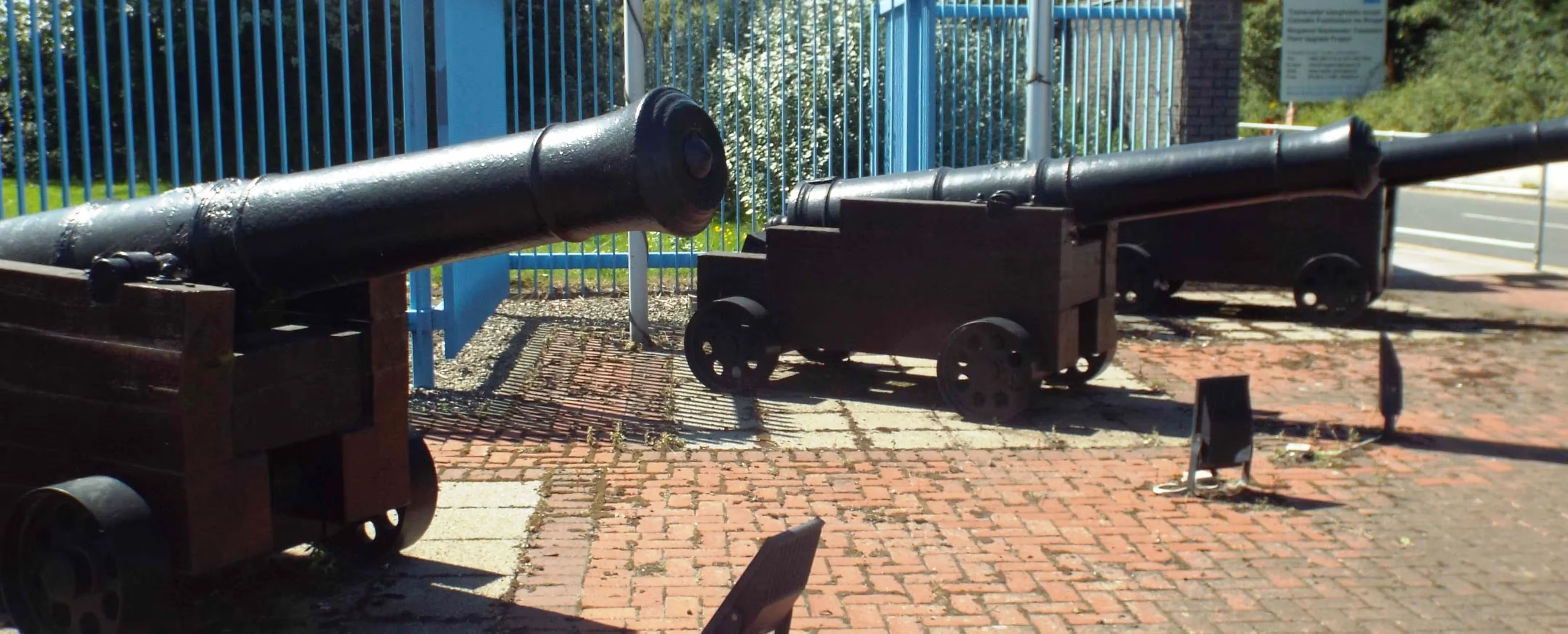
(Don Cameron Photo)
Three Cast Iron possibly 24-pounder Smoothbore Muzzleloading Guns, previously stood outside the Poolbeg Power Station, Dublin. Some time after the 1798 Rebellion, a fort was constructed near the Pigeon House Hotel and it became known as the Pigeon House Fort. In 2016, these three cannon stood outside the entrance to the ESB power station. They originally faced facing out to sea anticipating a possible French invasion that never came. The guns have been removed for restoration by the Electricity Supply Board (ESB), as the timber bases were in poor condition.
Dublin, Phoenix Park Visitor Centre

(E M Photo)
Cast Iron 3-pounder Smoothbore Muzzleloading Gun, 6-feet long, weight 7-2-14 (854 lbs). It has a CR cypher and inscription, but the barrel is damaged. This gun is inside the museum near Ashtown Castle and not far from the Magazine Fort.





